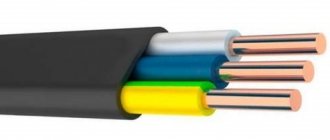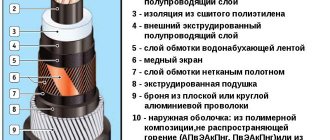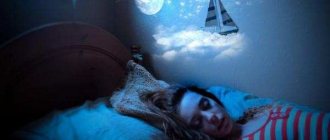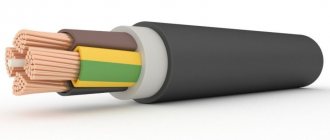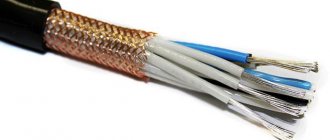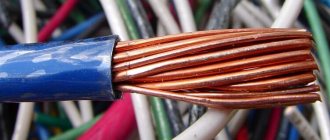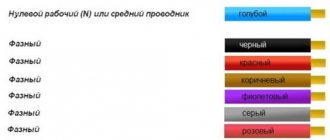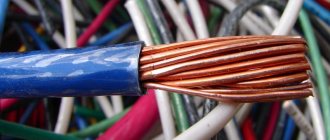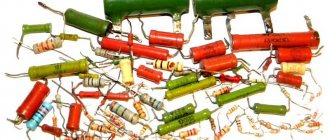Features of the VVGng-LS cable, 8 varieties of the VVG family. Full explanation of the name, gasket options, as well as the 3 best manufacturers. Review of 4 common mistakes. 18 types of power copper cables and approximate prices
TEST:
To understand whether you have sufficient information about the VVGng-LS cable and its purpose, take a short test:
- What causes heavy smoke to form when there is a fire in a building structure?
a) Insulation of cables running in walls.
b) Plaster covering the walls - due to the large amount of flammable materials in the composition.
- What do the letters LS at the end of the wire marking mean?
a) English Little Smoke.
b) English Low Smoke.
- In what case does the cable successfully pass all tests and be allowed into production?
a) When, when recreating real fire conditions, a cable that caught fire reduced the transparency inside the room by no more than 40%.
b) When workers conducted a computer simulation of a fire and smoke reduced the transparency inside the room recreated by the machine by no more than 40%.
c) Upon successful completion of the simulator and real conditions.
- What exactly ensures a reduced fire hazard of the cable?
a) Special NG spray (non-flammable) covering the cable.
b) PVC plastic covering the wire.
Answers:
- a) Strong smoke occurs due to the fire of the cable insulation layer.
- b) The designation LS is the English Low Smoke, which translates as “light smoke”.
- a) To carry out inspections, employees of cable manufacturing enterprises recreate exclusively real fire conditions where the cable is placed. The process uses a special device that detects changes in the transparency of the room due to smoke. If the indicator stops within 40%, then the cable is allowed to be used for installation in a real building.
- b) To reduce the level of fire hazard, cable manufacturers use special PVC plastic to cover the wire.
VVGng
A cable or wire with the designation VVGng LS is the best development of the family of all cable products bearing the abbreviation VVG. The secret of its popularity is the addition of the letters LS. To understand the meaning of the designation and the function of the cable, it is necessary to analyze this issue in detail.
Definition: Cable VVGng-LS is a conductor of electric current that can be laid openly in objects prone to fire.
When a fire occurs in a room, various smoke effects can occur, and when evacuating, people will simply suffocate from harmful smoke.
If a fire breaks out in a building, then it is the cables and various wires that in most cases become the main cause of the source of this smoke.
For safe operation, we have developed a special GOST R 5315-2009 - this is what they are guided by when laying cables. The marking “ng” indicates non-propagation of fire. They also added a special coating that produces low smoke and gas emissions if the cable catches fire.
7 explanations of the cable designation.
It is difficult for an ignorant person to determine what exactly the letters (VVGng LS) on the cable mean. To clarify this situation, you need to study the following transcript:
- VVGng ALS. Explanation of the letter A – flame retardation class according to GOST IEC 60332-3-22-2011. Explanation of the cable designation VVGNG and ls - aluminum wire with reduced gas and smoke emission.
- When the cable does not have the letter A at the beginning of the marking printed on the surface, this means that it has a copper structure.
- The first B indicates a special layer located on the outside and consisting of PVC material.
- The second B means the insulation of the internal conductors, consisting of PVC.
- The abbreviation NG means non-propagation of fire if a group or single gasket was installed.
- LS stands for Low Smoke in English. If translated into Russian, it will mean “light smoke.”
- Explanation of the coolant marking - single-core wire. If there is no such sign on the wire, then the cable is multi-core.
Transcripts
If the VVGng cable has the designation LS separated by a hyphen, this means a guarantee of low smoke and gas emissions when the wire catches fire.
The marking is only placed on the cable if successful testing has been carried out. To study the standard procedures for all tests that cables undergo for smoke generation, it is necessary to study GOST R IEC 61034-1(2)-2005.
To test for the above requirements, fire conditions are recreated inside the laboratory room - the cable is ignited, and then specially trained laboratory technicians measure the transparency of the air in this room. Measurements are carried out both after the wire is ignited and before under normal conditions.
Smoke will reduce the light transmission of the object, this is recorded by clearly tuned instruments. As a result of the test, workers will calculate the ratio of light transmittance after and before the experiment.
All indicators will be expressed exclusively as a percentage. According to GOST R 53769-2010, it is generally accepted that the cable will successfully pass the test if smoke has reduced the transparency inside the room by no more than 40%. Only in this case will the cable be set to LS.
To insulate the VVGng LS cable, PVC plastic is used, which leads to a reduced fire hazard. As a result of contact with fire, the insulation will emit a small amount of smoke. Manufacturers ensure that the resulting smoke is not toxic. This figure should be no more than 40 milligrams per cubic meter, according to GOST R 53769-2010.
The task is very difficult, but cable manufacturers have successfully coped with it using various specialized additives called additives and antipyrine.
Important! Such plastic compounds are used not only in Russia, but also abroad.
Russian manufacturers were able to successfully register several technical specifications (technical conditions that meet the requirements) - TU 2246-001-25795756-2009. They are used to produce the necessary plastic compounds, which are made specifically for insulating cores as internal and external filling.
Marking of cables and wires
6 structural features of the VVGng-LS cable
The location and composition of all elements of the VVG cable are very similar to its other counterparts, which have the same copper cores and a PVC insulating sheath.
For manufacturing, GOST R 53769-2010 is used.
The cable can be flat or round in shape and has a large number of veins inside.
The maximum number of cores is five.
The cores are made stranded, single-wire, sector or round.
To select the nominal values of the cross-sectional area, you need to use a single standard series.
Technical characteristics of VVGng LS:
Absolutely all characteristics of cables with PVC coating are standardized according to GOST R 53769-2010.
There are still slight variations in characteristics due to different manufacturing plants.
Important! The standard will not include indicators of the cross-section and shape of the cores, shell thickness, current resistance - all this applies to the general range of PVC plastic compounds. Only values applicable to insulation consisting of cross-linked polyethylene will be indicated separately.
According to GOST 53769-2010, the maximum tensile strength of the LS product may be slightly different from other types - it may be lower than that of VVG, but not different from that of VVGng.
It is also important to know 3 nuances about laying VVG cables
There are different ways to lay wires into the room:
- Open. Open cable laying is allowed only in structures consisting of concrete, plastered surface, plaster, brick and similar materials. Open cable routing is recommended if there are suspended structures such as a cable. But care should be taken to ensure reliable installation of the wire. If the wire will be laid under a suspended structure, then mechanical stress on the cable, such as sagging or stretching, should be avoided. Additional safety measures should be installed if the cable is damaged mechanically. If the cable is installed in a wooden, potentially flammable surface, then you need to use special corrugated tubes, metal sleeves or cable channels.
- Hidden. This installation option is used in residential premises. It is necessary to place the cable in the voids of the walls, and then cover it with plaster.
Important! Mechanical damage with this installation method is unlikely, and therefore there is no need to install additional protection. But if the walls are built of wood, then protection will still have to be installed.
- Laying cables in the ground. VVG cables cannot be laid without special protection. This is due to the fact that there is simply no natural protection that will protect the cable from mechanical stress. When laying underground, it is necessary to use special sealed boxes. In exceptional cases, additional means of protection are used, such as pipes or tunnels.
All work is carried out in accordance with SNiP 3.01.01-85, SNiP III-4-80. Other types of cables are also used for installation:
Other types
Other types
Wire design
The VVGng wire can contain up to 5 conductive cores. Depending on their characteristics, they can be assigned the first or second class in accordance with GOST 22483.
- According to their shape, the veins are sectoral or round.
- Each core has individual polyvinyl chloride insulation. Its thickness must be at least 0.3 mm. The insulation must fill all spaces between the cores, leaving no voids.
- The cores can be made in the form of a single wire or twisted from several. In the latter case (this is more typical for sectoral wires), manufacturers can abandon individual polyvinyl chloride insulation by covering the overlapped twist with a layer of thermally bonded fabric or polyethylene terephthalate film.
- As a rule, conductive wires are marked in different colors for convenience during installation work.
- The cable may have grounding and neutral conductors. They may differ not only in color (grounding - yellow-green, neutral - blue), but also in cross-sectional area. In this case, this is also displayed in the wire marking, for example, VVGng LS 5x10 + 1x5(N).
The size of the cross-section of the conductors directly depends on the expected load: the thicker the conductor, the greater the power of current that can be transmitted through it. Accordingly, the weight of the wire increases. So, a kilometer of cable (and it is in these units that the weight for this product is calculated) VVGng LS 5x10 will pull 756 kg, and the same section of VVGng LS 5x16 cable will already weigh 1103 kg. More accurate data is provided in special tables.
Products of this type are produced for voltages of 660 V and 1000 V at a standard AC frequency of 50 Hz. The wires in this case will differ in the thickness of the insulating layers, and therefore in diameter. Thus, the VVGng LS 3x2.5 cable for 660 V has a nominal outer diameter of 9.3 mm, and the same cable, but designed for 1000 V, has a nominal outer diameter of 10.2 mm.
How to avoid 4 mistakes when laying cables
- First you need to plan everything and determine the devices that need to be connected and their location. Otherwise, the work will have to be redone.
- It is advisable to remove the old wiring and replace it with a new one during repairs. This way many troubles are avoided.
- The distance between the power and data cables should be 30 cm or more. The wires must be parallel to each other. If these conditions are not met, the signal will be interrupted.
- When making calculations, you need to take into account that the main line is located near the ceiling, and the sockets are located below.
Decoding the abbreviation
There are certain instructions for carrying out work with electrical installation products, which indicate the mandatory use of VVGng cable. This wire is considered non-flammable. Upon detailed study of the price-quality ratio, we can conclude that this is the best option for wiring industrial buildings.
The VVG cable is considered universal, because it can be laid in buildings made of flammable materials and in buildings with high humidity. It is very important to be able to correctly decipher various markings for people who lay conductors in buildings for personal use, as well as for builders. If you know what a certain letter means, you can easily determine all the necessary properties. Thanks to this, a person will be able to buy in the store the optimal type of cable for specific work. Letter designation:
- If there are no other symbols on the cable other than VVG, this means that the current-carrying conductors are made of copper.
- If there is the letter A, then the cores are made of aluminum.
- B - means that the insulating sheath is made of PVC.
- PV - polyethylene.
- P - the insulating shell of the cores is made of polymer materials.
- B - armored conductor.
- G - the conductor is naked, that is, there is no armor.
- The second symbol P indicates that the outer insulation is made of polymer.
- Shp is a special protective polyethylene hose.
- Ш - protective shell.
- Second B - the outer insulating shell is made of PVC.
LTx marking
The prefix LTx or low toxic on the cable indicates low toxicity. The designation was fixed in GOST from 2009 and changed in GOST from 2012. Cables with this marking must be laid in kindergartens and hospitals. According to government standards, such conductors must have minimal toxicity. Such conductors include armored power cables VBShvng(A)-LSLTx and MKKShVng(A)-FRLSLTx. The marking is present on conductors with aluminum conductors AVVGng(A) and AVVGEng(A) in LSLTx and FRLSLTx versions. Also, control AKVVGng(A) with universal wires MKShVng(A), MKESHVng(A), fire alarm cables and optical conductors have this marking. The LTx prefix is available in ParLan U/UTP Cat5e PVCLS twisted pair.
Design features
The flexibility of a multi-core cable increases with the number of wires per certain cross-sectional area, S. For example, a cable consisting of 10 cores, total S = 5 mm², has less flexibility and resistance to kinks than a 50-core cable with the same cross-section. But the latter oxidizes faster and corrodes, which increases the internal resistance and wear of the cable.
This property must be taken into account to achieve optimal results when choosing. For stationary wiring, it is better to use a cable with cores consisting of one current conductor. If it is subject to large bends during operation, then it is better to use a stranded one from a small number of strands (for example, carriers, extension cords).
Flat cable is more often used as power conductors. Since its wires are arranged in a row, this reduces the parasitic effect between the electrodes, which is noticeable under heavy loads.
Expert opinion
Viktor Pavlovich Strebizh, lighting and electrical expert
Any questions ask me, I will help!
Insulated cable cores must be twisted, the empty space between the twisted insulated cores must be filled with bundles or a mixture of insulating materials. If there is something you don’t understand, write to me!
Application area
Power cables are needed to transmit and distribute electricity in a stationary installation with an alternating and direct voltage of one kilowatt. Can be used in places where there is a temperate, cold and tropical climate. It is laid where there is no danger of mechanical damage. Installed on a special cable rack, in a fire-hazardous room, in explosive conditions and for laying group lighting networks where there are explosive zones of class B-Ia.
Note! Needed to protect unarmored cable elements subject to vibration. Not capable of spreading fire. Required so that cable structures and premises can function properly. They heat up to no more than 80 degrees and work no more than 8 hours a day.
Cable application area
GOST (TU / VDE) cable VVGng(A)-LS:
- GOST 31996-2012 (general GOST);
- TU 16.K71-310-2001 (Electric cable; KhKA; Kavkazkabel; Tverenergokabel; Irkutskkabel; Agrokabel; Belaruskabel; VKZ; Kaluga cable plant; Moskabelmet; Podolskkabel; Rybinskkabel; Rezhkabel; Sevkabel; SKK; Sibkabel; Chuvashkabel; ELKAB; Energokompl ect; Kamkabel ; Alur; Beltelekabel; VIM-Cable; Dmitrov-Cable; Kirskabel; Lyudinovokabel; Pskovkabel; ROSSKAT; Saranskkabel; SPKB TECHNO; Smolensk Cable Plant; TATKABEL; Energokabel Plant; EM-CABLE; )
Fire safety designation
In addition to other designations, special attention must be paid to fire safety markings, which is very important. Main parameters:
- The ng-frhf conductor can be used for group conduction - in the event of a fire, the fire will not spread. This is due to the fact that gaseous substances will not be formed during the combustion process.
- The designation ngfr-ls indicates a low spread of smoke and gaseous substances. This product can also be used in group settings.
- The ng-hf marking indicates that in the case of group wiring, no actively corrosive gaseous substances are formed in the event of a fire. In addition, such a conductor does not burn.
- The letters ng-LS indicate low levels of smoke and gas emissions. If the cable comes into contact with an open flame, combustion will not spread.
- Cable VVG-Png A - decoding indicates that the conductor is flat and is not subject to combustion even in an open fire.
You may be interested in this Features designation of phase and zero
If you are guided by this information, you can easily determine how popular conductors are deciphered. Some of them:
- VVG-Png is a flat, non-flammable cable, without armor, the outer and inner sheaths of which are made of polyvinyl chloride.
- VVGng A LS is a conductor, the inner and outer layers of which are made of PVC, non-flammable, low levels of smoke are emitted, the conductors are made of copper.
- For the VVG-Png A LS wire, the decoding is completely identical to the previous one, the only difference is that this type of cable is flat.
Section
The minimum diameter of the zero, main core is 1.5 square millimeters. To measure the cross-section of the wire, you need to look at the end section with the area. The cross section can also be determined using the diameter formula. All you need to do is multiply the value of the vein diameter by the same value, and then multiply the total value by 0.785.
To calculate the cross-section of a multi-core conductor element, it is necessary to multiply the cross-section of one core by their number. The diameter is determined with a caliper or micrometer, accurate to 0.01 millimeters. In the absence of instruments, a classic ruler will help.
Note! The larger the wire cross-section, the better.
Cable cross-section table
Manufacturers
Every year more and more cable manufacturers appear on the market. But experienced professionals recommend contacting companies that have been operating for over 10 years and have positive reviews. Below is a list of leading factories on the Russian market.
LLC "GK "Sevkabel"
This is one of the first cable factories in Russia. The plant was founded back in 1879 by a German scientist. The company produces more than 25,000 thousand types of cables. The factory has an impeccable reputation.
Saranskkabel LLC
The factory was founded in 1950. In 2010, the enterprise underwent modernization. The range has been expanded with new cable models. They also have a testing center for cable products.
Indoor storage
LLC "EM-CABLE"
Factory with branches in different parts of the country. They produce cable models with different protection against mold, fungi and insects. Fast delivery and individual approach to each client. They have a high rating in the country.
LLC "KZ "Expert-Cable"
The factory was founded relatively recently, in the spring of 2014. One of the young, but well-established on the Russian market.
The assortment is not so large yet, but it is of high quality. Cables are manufactured using the latest technologies. They also deliver to any corner of the world.
In conclusion, it should be noted that VVGng-LS products are more suitable for large enterprises and industrial facilities. Before purchasing, it is advisable to take a closer look at the above-mentioned factories.
Cable testing and production
Manufacturers, before marking the conductor as non-flammable, test the products using various methods. To carry out testing in laboratory conditions, a real fire situation is simulated. Then the specialist, using certain equipment, measures the transparency of the air inside the fire room. All measurements should be taken twice: initially, and then after the fire.
Smoke reduces the permeability of light inside the room, and this fixes the device. Then the specialist calculates the ratio of the values before and after the experiment. For the cable to pass the test, the transparency in the room should not change by more than 40%. Only then is the appropriate marking applied to the product.
Today, several domestic companies are engaged in the production of VVG wire. Among them:
- "Sevkabel" (St. Petersburg).
- "Concord" (Smolensk).
- "Moskabelmet" (Moscow).
- "Podolskkabel" (Podolsk).
Knowledge of the decoding of VVG conductor markings is very important in the process of designing and laying wiring of various structures. If operating conditions are met, manufacturers promise that the cable will function fully for at least 30 years. In addition, a 5-year warranty is provided from the date of installation.
Technical specifications
During emergency operation, the operating temperature should not be higher than 85 degrees. In this case, the total number of hours at high temperature will be 1000.
Marking VVG ng
VVGng product characteristics:
| Permissible air humidity | Not higher than 95% |
| Maximum guarantee | 3 years |
| Test voltage | 3 kV |
| Maximum permissible wire temperature | 85 degrees |
| Maximum permitted voltage | 0.68 kV |
| Laying at ambient temperature | −15 to 10 degrees |
| Product bend radius | 8 outer diameters |
| Permitted minimum and maximum temperatures | From −50 to 70 degrees |
| Critical wire temperature during short circuit | 180 degrees |
There is also a subtype of cable VVGng hf with technical characteristics as indicated above, but with a lower operating temperature. From −45 to 40 degrees.
